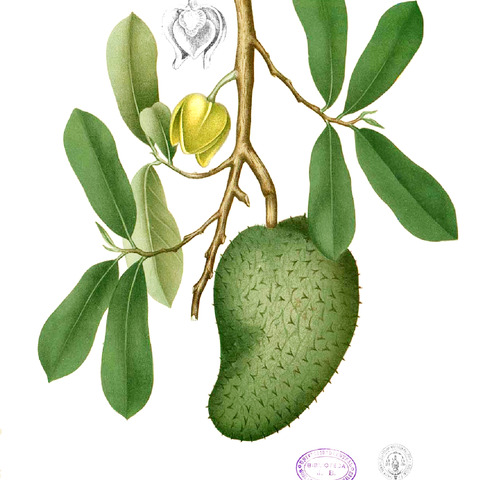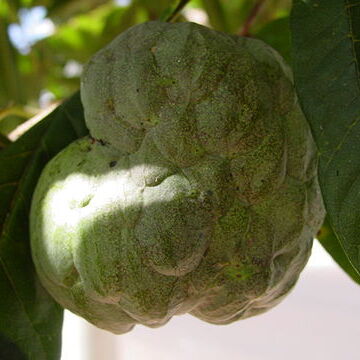Trees, shrubs, or climbers, wood and leaves often aromatic; indument of simple or less often (Uvaria, Annona) stellate hairs. Leaves alternate, normally distichous. Stipules absent. Petiole usually short; leaf blade simple, venation pinnate, margin entire. Inflorescences terminal, axillary, leaf-opposed, or extra-axillary [rarely on often underground suckerlike shoots]. Flowers usually bisexual, less often unisexual, solitary, in fascicles, glomerules, panicles, or cymes, sometimes on older wood, usually bracteate and/or bracteolate. Sepals hypogynous, [2 or]3, imbricate or valvate, persistent or deciduous, rarely enlarging and enclosing fruit, free or basally connate. Petals hypogynous, 3-6(-12), most often in 2 whorls of 3 or in 1 whorl of 3 or 4[or 6], imbricate or valvate, sometimes outer whorl valvate and inner slightly imbricate. Stamens hypogynous, usually many, rarely few, spirally imbricate, in several series; filaments very short and thick; anther locules 2, contiguous or separate, rarely transversely locular, adnate to connective, extrorse or lateral, very rarely introrse, opening by a longitudinal slit; connectives often apically enlarged, usually ± truncate, often overtopping anther locules, rarely elongated or not produced. Carpels few to many, rarely solitary, free or less often connate into a 1-locular ovary with parietal placentas; ovules 1 or 2 inserted at base of carpel or 1 to several in 1 or 2 ranks along ventral suture, anatropous; styles short, thick, free or rarely connate; stigmas capitate to oblong, sometimes sulcate or 2-lobed. Fruit usually apocarpous with 1 to many free monocarps, these sometimes moniliform (constricted between seeds when more than 1-seeded), often fleshy, indehiscent, rarely dehiscent (Anaxagorea, Xylopia), and often with base extended into stipe, rarely on slender carpophore (Disepalum), less often syncarpous with carpels completely connate and seeds irregularly arranged and sometimes embedded in fleshy pulp. Seeds 1 to many per monocarp or many per syncarp, often arillate; endosperm copious, ruminate; embryo minute, near hilum.
Trees, shrubs, rarely woody vines, deciduous or evergreen, with aromatic bark, leaves, and flowers. Pith septate to diaphragmed. Leaves alternate, simple, without stipules, petiolate. Leaf blade pinnately veined, unlobed, margins entire. Inflorescences axillary to leaf scars on old wood or to leaves on new shoots, solitary flowers or few-flowered fascicles, pedunculate; bracts or bracteoles present or absent. Flowers bisexual, rarely unisexual; receptacle becoming enlarged, elevated or flat; perianth hypogynous, segments valvate or imbricate; sepals persistent, (2-)3(-4), distinct or basally connate; petals either 6 in 2 unequal whorls of 3 with petals of outer whorl larger, petals of inner whorl fleshier than the outer, often with corrugate nectary zone, or petals 6-12(-15), nearly equal or unequal, veins impressed on inner face; stamens 10-20 or very numerous, hypogynous, spirally arranged, forming ball or flat-topped mass; filament short, stout; anther linear to oblong-linear, extrorse, longitudinally dehiscent; connective apically elongate, connivent; pistils 1-many, superior, 1-carpellate, 1-locular, distinct or connate to various degrees with at least stigmas distinct; placentation marginal, placenta 1; ovules 1-many per pistil; style short, thick; stigma terminal. Fruits berries, distinct, 1-8(-12) per flower, or coalescent, forming syncarps, 1 per flower. Seeds 1-many per pistil, arillate; endosperm ruminate, oily.
Trees, shrubs or lianas usually with striate bark. Leaves and bark often aromatic. Leaves simple, mostly distichous-alternate, entire, pinnately veined, exstipulate. Inflorescence determinate, terminal, axillary, leaf-opposed, internodal, ramal or cauline. Flowers often solitary or in rhipidia, sometimes fasciculate. Pedicels medially or basally articulated, bracteate. Flowers mostly hermaphroditic, hypogynous, actinomorphic. Sepals 3, free or connate, valvate or imbricate. Petals commonly 6 in 2 series of 3, rarely 3, 5, 7 or 8, free or connate, valvate or imbricate, sometimes apically coherent. Stamens mostly numerous and spirally arranged; filament short, connective often expanded or extended above anther; anther thecae extrorse or latrorse by longitudinal slits. Pollen grains solitary or in tetrads or polyads. Gynoecium of few to numerous free, rarely connate, conduplicate carpels on a flat, convex or rarely hollowed receptacle. Ovules 1–many, mostly anatropous, usually basal if 1 or 2, otherwise marginal. Fruit 1–many, mostly fleshy, indehiscent apocarps or rarely dehiscent (follicles), rarely syncarpous, 1–several seeded. Seeds transverse or longitudinal to long axis of apocarp, sometimes arillate. Endosperm ruminate.
Stamens ?, spiral, or 6–12 and whorled (sometimes staminodial) with anthers linear to semi-orbicular, lateral or extrorse (rarely apical); connective usually prolonged beyond the thecae, with the apex truncate, oblique, capitate, convex, conical or acute; filaments usually very short or absent, free, rarely more elongate and united in a cone over the gynoecium (Xylopia)
Trees, shrubs, or lianes (rarely rhizomatous shrublets), glabrous or with an indumentum of simple, stellate or lepidote hairs; bark usually smooth and entire, pale grey or buff to brown, the branches often reddish to purple-black with lozenge-shaped striations, pubescent or tomentose (rarely glabrous) when young; pith septate, oil cells present
Flowers morphologically terminal (i.e. terminal, supra-axillary, extra-axillary or leaf-opposed) or axillary, solitary or paired to fasciculate or cymose, on the young or old wood, sessile or pedicellate, more rarely pedunculate, actinomorphic, bisexual or more rarely unisexual, often fragrant
Fruit apocarpous with ripe carpels baccate (fleshy or lignified) or rarely dehiscent, stipitate or sessile, or syncarpous with either aggregated 1-seeded carpels or 1-locular and ?-seeded, Seeds vertical to horizontal, sometimes arillate, with abundant ruminate endosperm; embryo minute
Petals 6 (4) in two equal or ± unequal whorls (more rarely one whorl of 6, 4 or 3), imbricate or valvate (rarely open) in bud, free or ± united at the base, usually alternating with the sepals
Carpels ?–1 free or united at the base, or completely united to form a 1-locular ovary (Monodora); ovules ?–1: styles free or united, or absent
Carpels numerous or rarely few or solitary, free or very rarely united into a 1-celled ovary with parietal placentas; ovules 1 or more
Petals generally 6, in two series, valvate or slightly imbricate, rarely in two series of 2, or the inner series absent
Flowers terminal, leaf-opposed or axillary, solitary or crowded, hermaphrodite or rarely unisexual, mostly trimerous
Sepals 3, rarely 2, separate or united into a 3-lobed calyx, valvate or rarely imbricate, persistent or deciduous
Stamens generally numerous, hypogynous; anther-cells adnate, with the connective often truncate
Leaves alternate in two rows, entire, penninerved, membranous to coriaceous, exstipulate
Seed with or without an aril, with copious ruminate endosperm and minute embryo
Fruiting carpels sessile or stipitate, mostly indehiscent
Sepals 3 (2), usually valvate in bud, free or ± united
Leaves alternate, entire, exstipulate
Trees, shrubs or climbers, aromatic


